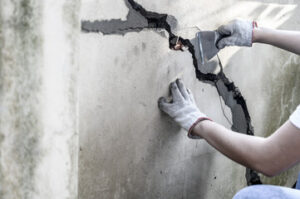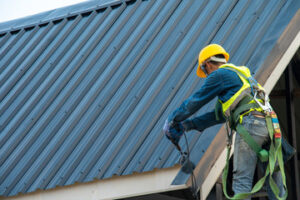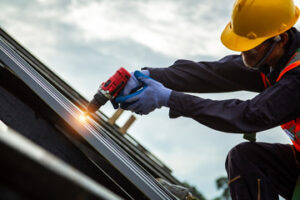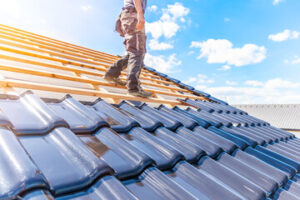Concrete Repair addresses damage to existing concrete structures and can improve safety by reducing trip hazards. It can also extend the lifespan of the structure preventing costly replacements in the future.

The type of repair needed depends on the extent and cause of the damage. Structural repairs focus on strengthening the existing concrete while decorative repairs address a surface’s appearance. Visit https://www.concreterepaireauclaire.com/ to learn more.
Cracks are one of the most common problems found with concrete surfaces. These small imperfections can quickly grow into much larger problems if left untreated. Proper maintenance can help reduce the occurrence of cracks in your concrete, but if you do encounter them they can easily be repaired with a few basic tools and supplies.
Before you begin, it is important to clean the area and remove any debris or dirt that might be in the crack. This will make sure that the repair material will bond properly and prevent the problem from occurring again in the future.
The next step is to prep the area by chiseling out the crack with a hammer and masonry chisel tool to widen and detach any loose material from the old concrete. This will create a mechanical bond as well as a chemical one between the repair material and the concrete. Once you have chiseled out the crack and removed any loose material, it is time to apply the concrete repair product of your choice. This can be an epoxy or latex based mix, depending on your specific needs and the type of crack. You will want to follow the directions on the product you have chosen for best results.
Once the application is complete, you will need to allow the concrete to cure according to the product instructions. It is a good idea to place a piece of plastic loosely over the surface if it is exposed to the elements to keep the sealant from drying too fast and causing damage.
Choosing the right products for the job is key to having a successful and long-lasting concrete repair project. When shopping for concrete repair products, look for high quality and easy to use options. Look for products that have been tested and approved to ensure they provide a quality finish. It is also important to consider environmental friendly and non-toxic options, as they will be safer for the environment as well as employees or volunteers working on the repair project.
Concrete Repair is an essential part of maintaining your commercial property. By addressing any issues as soon as they arise, you can help protect your investments and prevent further problems in the future.
Repairing Delaminations
Delamination in concrete is a serious safety concern, especially for facilities that handle heavy loads. It can also cause further deterioration of the concrete, leading to costly repair and replacement costs. If not addressed, delaminations can lead to structural damage and even failure of the entire structure. Fortunately, there are several concrete repair options that can be used to fix delaminations. Depending on the type of damage, these repair methods can range from surface leveling to structural repairs.
The first step in concrete repair is to identify the source of the problem. This will involve a visual examination and a delamination survey. This will help to determine the extent of the problem and what needs to be done to correct it.
Once the issue has been identified, the next step is to prepare the damaged area for the repair process. This will include removing loose debris and ensuring that the area is saturated surface dry (SSD). This is necessary to ensure that the concrete is ready for the new material.
In some cases, it may be necessary to remove the existing concrete. This can be done with a jackhammer or chisel, depending on the severity of the delamination. Once the concrete has been removed, it should be cleaned and sanitized to remove any corrosion products and chemical contaminants that could lead to future problems.
For concrete delaminations that are not severe enough to warrant tearing out the concrete, there are several repair options available. One option involves injecting epoxy into the concrete. This method can be effective in repairing delaminations in industrial floors.
Another option is to use a polymer-modified cement. This mixture is added to the concrete during mixing and forms a co-matrix of hydrated cement and polymer film throughout the concrete. This has been shown to improve the tensile strength, bond strength and abrasion resistance of the concrete.
No matter which concrete repair option is selected, it is crucial that it is applied properly to ensure long-term success. It is important to follow all the instructions for use, including proper mixing times and application techniques. Also, it is essential to use high-quality products and to allow adequate time for curing. If not done correctly, the repair will not last and may actually cause further damage to the concrete.
Repairing Leaks
When water leaks from concrete walls and structures it causes significant damage. Not only does it affect the structural integrity of the structure but can lead to mould spores growing within the porous concrete surface which in turn can break down the concrete itself. Therefore, it is very important that any leaking concrete cracks are repaired as quickly as possible. There are a number of different products available to help stop leaking concrete cracks; these include foams, quick-setting mortars and epoxy resins. The best option is to prepare the crack by using an electric chipping hammer to chisel through the entire length of the crack to create a deep, narrow chase, then fill in with the chosen product.
If a leak occurs from a concrete wall it is recommended that the waterproofing sealant is extended over 100 to 150 mm beyond the edge of the crack. This will ensure the repair is fully sealed and waterproof. Alternatively, the leak can be treated as a hair crack and a brush-on repair product such as Drizoro Maxjoint Elastic can be applied to the area. This will look like a normal finish and add further protection to the repaired crack.
Slab leaks are typically caused by some type of failure in the plumbing system. They can be a result of faulty installation, weakened water lines, chemical reactions between metals in the plumbing system and metals in the earth to which they are exposed, or even soil shifting beneath the slab that causes movement and a leak.
A slab leak can cause serious problems for homeowners as it can damage the interior of their home and result in severe water damage, mold growth and expensive repairs to appliances, flooring and other items. It is extremely important that these leaks are dealt with as soon as possible to prevent further damage to the property and to ensure the safety of the occupants.
As with new construction, restoration projects are often bid on a fixed unit price basis with estimated quantities. In many cases, the actual quantity of work that needs to be completed exceeds estimates. Therefore, engineers usually recommend that associations budget a contingency of about 25 percent.
Repairing Potholes
Potholes in concrete are a common problem that can cause damage to vehicles and hurt pedestrians. Keeping up with repairs can help extend the life of the surface and prevent more costly damage in the future.
There are several ways to repair cracks and potholes in concrete. One method involves removing the damaged area and replacing it with new concrete. Another approach uses a mixture of cement, water, and aggregate to fill small holes and repair cracks. Finally, slurry seal is used to repair smaller areas that do not require a full removal and replacement of the pavement.
To patch a pothole, first remove any loose debris and clean the area. Then, prepare the hole for patching by smoothing the edges. Mix QUIKRETE Blacktop Repair or a comparable product according to the package instructions. Pour the mixture into the hole and spread it evenly. Use a tamp or hand tool to compact the concrete and eliminate any voids. Finish the patching by tamping again and covering with bonding tape to avoid water ingress.
The best time to repair a pothole is during dry and moderate weather conditions, typically late spring through early fall. The repaired pothole should be allowed to cure for several days before allowing heavy traffic. Curing helps increase the strength of the repaired concrete and ensure it will withstand the demands of traffic.
If your concrete surface has a hole that does not fit the description of a crack or delamination, it may be caused by corrosion. Corrosion can happen when moisture seeps into the concrete and dissolves the steel reinforcement. This can leave a hole in the surface of the concrete that can be repaired using a chemical repair product.
To repair corrosion, a chemical product should be applied to the hole and then allowed to set. Once set, a patch should be added to cover the corrosion and fill the hole.
Regular inspections and proactive repair of minor problems are the best way to maintain safe and functional concrete surfaces. Inspecting for and addressing cracks, leaks, surface wear, and other signs of deterioration is essential to extending the life of your concrete. Investing in routine maintenance and repairs can also reduce the frequency and cost of larger repairs.







